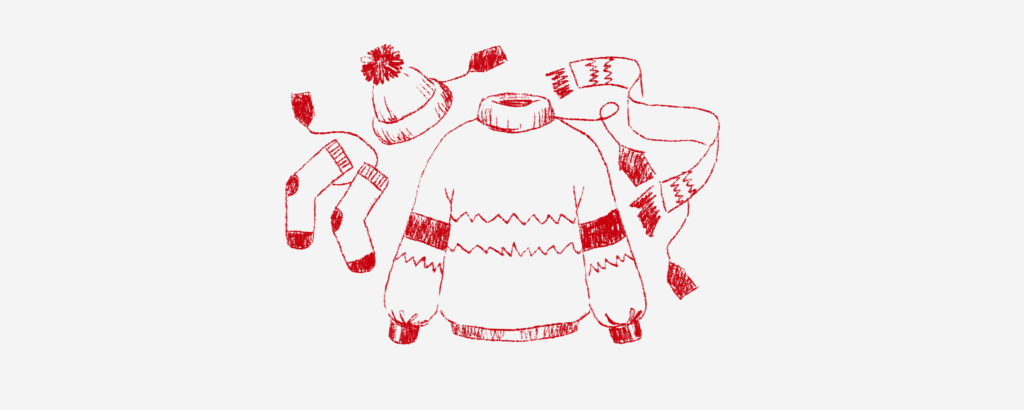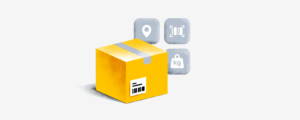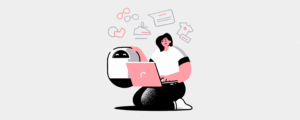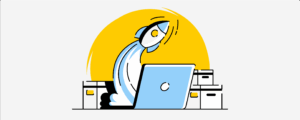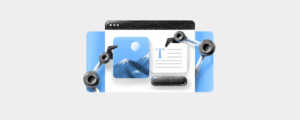
Thinking about launching a clothing business, but the thought of managing inventory feels overwhelming (and expensive)? You’re not alone. Many entrepreneurs and small business owners face the same challenge when considering how to get started in the fashion world.
Luckily, there’s some good news! Advances in ecommerce now make it possible to sell clothes online without holding any inventory.
This blog explores several models, their pros and cons, and how to get started using tools like Ecwid by Lightspeed.
How to Test a Clothing Website Without Buying Inventory
Whether you’re an established business owner testing a new product idea or an aspiring entrepreneur preparing to launch your first online boutique, there are proven ways to make it happen with minimal upfront investment.
Here’s a quick overview of the most popular business models for selling clothes online without holding inventory:
- Print-on-demand
- Dropshipping
- Curated store with supplier-managed fulfillment
- Promoting other brands’ clothing.
Let’s dive into each model, exploring its strengths, weaknesses, and the businesses it best serves.
Print-on-Demand
This option is worth considering if you’d like to learn how to sell online without inventory.
Print-on-demand, or POD, is an excellent way to sell custom-designed clothing online without the hassle of stock management. It lets you turn your unique designs into real products, such as T-shirts, hoodies, sweatshirts, and more.
How It Works
Here’s how print-on-demand operates:
- You design the artwork or pattern you’d like to print on your clothing.
- You upload your designs to a print-on-demand platform.
- You list those designs as products in your online store.
- After a customer places an order in your online store, the print-on-demand service handles production and shipping.
This process allows you to focus on your creativity without the hassle of dealing with printing machines, managing inventory, or worrying about warehousing.

Print-on-demand services typically offer a wide variety of apparel options that you can customize with your own designs
Why Use POD?
As with any business model, print-on-demand services come with both benefits and drawbacks. Let’s begin by exploring the key advantages they can offer your business:
Pros:
- No upfront costs to produce clothing since items are only made after a sale.
- Easy integration with ecommerce platforms like Ecwid for automation.
- You can offer a wide range of items without investing in inventory.
Cons:
- Profit margins can be lower due to the cost of production and shipping.
- Limited customization options beyond the designs you upload.
Who Should Use POD?
With print-on-demand, you don’t need to invest in expensive printing equipment or worry about warehousing space. This makes it ideal for creatives, graphic designers, and brands wanting to test new ideas, like selling T-shirts online without inventory.
Remember, print-on-demand services often offer a limited selection of products for showcasing your designs. However, if you’re wondering how to sell t-shirts online without inventory, this option might perfectly suit you, as t-shirts are the most common product POD services offer.
POD Platforms to Explore
There are plenty of print-on-demand platforms to choose from, each with its own set of features and pricing models. Some popular options include:
- Printful — One of the leading print-on-demand platforms that integrates with major ecommerce platforms like Ecwid.
- Printify — Another print-on-demand service that allows you to add your design to a wide range of products, including clothes. It syncs with Ecwid, too.
- Redbubble — An online marketplace that acts as a middleman between customers and artists. They offer various products, including apparel, home decor, and accessories.
- Society6 — Another popular platform for artists and designers looking to sell their work on various products.

A customizable t-shirt example available through Printful
Pro Tip: Pair your POD workflow with Ecwid to synchronize your store and manage orders effortlessly. Ecwid is a powerful ecommerce platform designed to help you create a stunning, professional online store in just minutes.
Set up a stunning online store with Ecwid, and once integrated with Printify or Printful, your custom-designed products will automatically appear in your Ecwid store, ready to sell.
Ecwid also integrates with other print-on-demand services, such as Popcustoms, Printy6, and FlexCreate.
Dropshipping
This option is worth considering if you’re looking into how to test market clothing without buying inventory.
Dropshipping is a popular way to sell clothes without inventory: you act as the middleman between a supplier and your customer.
How It Works
Here’s how drop shipping clothes works:
- A customer orders a product from your online store.
- You send the order and customer details to the dropship supplier (this can be automated with platforms like Ecwid).
- The dropship supplier packages the product and ships it to the customer under your name.
Dropshipping lets a third-party company, like a manufacturer, wholesaler, or fulfillment service, handle producing, storing, packing, and shipping products to customers. Your job is simply to market and sell the products as if they were your own.

You can explore dropshipping suppliers on platforms like Alibaba and others
Why Use Dropshipping?
If you’re looking to sell clothing without managing inventory, dropshipping offers several advantages—but it’s important to consider the drawbacks as well.
Pros:
- No need to store or manage inventory.
- Wide product range, which lets you experiment with different styles and categories.
Cons:
- Lesser control over product quality, as you rely on the supplier.
- Shipping times may vary significantly, especially for international suppliers.
Who Should Use Dropshipping?
This model suits entrepreneurs who want to offer a large catalog and test various styles quickly. So, if you have a specific niche in mind (e.g, you’re wondering how to start an online shoe store without inventory), it’s a good idea to consider.
Since dropshipping is a great way to test out different styles, trends, and products quickly, it helps you identify what resonates most with your target audience and adapt your offerings accordingly.
Platforms to Explore
For those wondering how to start an online boutique without inventory, the market is full of dropshipping platforms to explore. Some of the most popular choices include:
- Alibaba — This platform offers a wide selection of products at competitive prices. It also has a feature called “Trade Assurance,” which provides buyers with added security by guaranteeing product quality and on-time delivery.
- Spocket — If your target audience is based in the United States or Europe, Spocket may be a good option for you. It specializes in connecting dropshippers with suppliers from these regions, offering faster shipping times and higher quality products.
- Syncee — Another platform that offers a large database of suppliers from all over the world, making it easier to find products for your niche, including fashion.
- Wholesale2B — This platform connects you with over 100+ dropship suppliers and offers various services, such as data feed integration, order fulfillment, and automatic inventory updates.
Pro Tip: Create an online store with Ecwid and connect it to Alibaba, Spocket, Syncee, or Wholesale2B to start dropshipping clothes quickly.
By the way, you can integrate multiple dropshipping services into your Ecwid store, allowing you to offer a diverse product selection to your customers.
If you’d like to test other dropshipping services, Ecwid also integrates with Sup Dropshipping, ScaleOrder, Dsers — Aliexpress dropshipping, AppScenic, and AmaZone + Walmart DropShipper. Discover them all in the Ecwid App Market.

Spocket is a great dropshipping solution for selling to audiences in the US and the EU
Curated Boutique with Supplier-Managed Fulfillment
Want the feel of a premium online boutique without stocking shelves? You can create a curated boutique where you handpick products that align with your brand, and suppliers handle fulfillment, shipping, and logistics on your behalf.
You might be wondering how outsourcing order fulfillment is different from dropshipping. The key difference is who owns the inventory.
In dropshipping, the supplier owns, stores, manages, and ships the products. With outsourced order fulfillment, the seller owns the inventory, but a fulfillment company handles packing, processing, and shipping. The inventory is stored at the fulfillment company’s facility, too.
If you outsource order fulfillment, you’ll still need to purchase inventory (unless your supplier supports the dropshipping model). However, you won’t have to handle inventory storage, management, or shipping. This frees up your time and resources to focus on other aspects of your business, such as marketing and customer engagement.
How It Works
Here’s how you can create a curated boutique with supplier-managed fulfillment:
- Choose a niche for your boutique (e.g., sustainable fashion or party dresses). Focusing on a specific niche or target audience will help you curate products that appeal to your ideal customers.
- Find wholesale suppliers who will ship products directly to your customers.
- Select the products you want to feature in your store, and let the suppliers handle order fulfillment for you.

Alibaba features hundreds of reliable suppliers, making it easy to explore which ones provide order fulfillment services
Why Use Fulfillment by Wholesale Suppliers?
This option may be more challenging to implement since it requires researching suppliers that provide fulfillment services. However, the potential benefits make it well worth considering.
Pros:
- Boutique-style branding that sets you apart from other ecommerce stores.
- No need to manage stock and fulfilment.
Cons:
- Finding suppliers with fulfillment services can be time-consuming.
Who Should Use This Model?
Business owners who value brand identity and want to offer a tailored clothing line without managing inventory.
Platforms to Explore
Alibaba is worth highlighting once more for its extensive network of suppliers and wide range of options. Similarly, Aliexpress stands out as a valuable platform.
You can also explore specialized wholesale platforms to discover more clothing suppliers:
- FashionGo — Online wholesale marketplace for clothing, shoes, and accessories
- Modalyst — A platform connecting you with clothing distributors and vendors specializing in dropshipping.
Pro Tip: Choosing the right supplier is important, but having a well-designed website matters just as much.
Your ecommerce website is a key touchpoint for your customers, so it’s essential to design it in a way that highlights your clothing line the best. Ecwid makes this easy with a variety of site templates created specifically for apparel stores.

Explore a range of professionally designed site templates by Ecwid, tailored specifically for apparel businesses
Promoting Other Brands’ Clothing
You don’t always have to sell your own products to earn money in the fashion industry. Instead, you can generate income by promoting other brands’ clothing and earning a commission for your efforts.
This approach is especially great if you want to start small or don’t have your own inventory. Let’s explore two popular methods you can use to make this happen.
Affiliate Marketing
With affiliate marketing, you earn a commission every time someone buys a product using your referral link. It allows you to make money by sharing products you believe in through blogs, social media, or websites.
Affiliate marketing might appear straightforward, but it has its own intricacies:
Pros:
- No need for inventory or customer service.
- Completely hands-off logistics.
Cons:
- Commission rates can be relatively low.
- Having a well-established online presence (a website, blog, social media page) is a must.
Platforms to explore:
- Amazon Associates — Amazon is the biggest online retailer, so it’s no surprise that their affiliate program is popular among bloggers and content creators. It has a wide range of products, including clothes, shoes, and accessories.
- LTK (formerly rewardStyle and LikeToKnowIt) — A popular affiliate marketing platform for fashion and lifestyle bloggers.

Many brands feature affiliate programs on their websites—take the time to research those that align with your content
Social Media and Influencer Partnerships
Social platforms like Instagram and TikTok have transformed how people shop. Take advantage of this! If you have a significant following, you can monetize it by collaborating with brands to showcase their clothing in your content and earning rewards for doing so.
Pros:
- Direct access to your audience.
- No need to handle products or logistics.
Cons:
- Requires a strong social media presence and consistent engagement.
Platforms to explore:
- TikTok Creator Marketplace — This is a platform designed for TikTok creators to collaborate with brands.
- Meta Creator Marketplace — Similar to the TikTok marketplace, this platform allows influencers on Instagram and Facebook to connect with brands.
Pro Tip: Meta offers Shops and shoppable content features, allowing users to purchase products directly through the app (availability may vary by country). You can tag other brands’ products in your content, making it easier for your followers to purchase products from your posts.

Followers can tap on a post to see detailed product information
Alternatively, if you have your own clothing store, you can sync your product catalog with your Instagram or TikTok pages using Ecwid, allowing your followers to shop your products directly within the app.
How to Pick the Right Model to Sell Clothes Without Inventory
Deciding between print-on-demand, dropshipping, or promoting other brands depends on your goals. Consider these pointers:
- Want to create clothes with your own designs? Go for print-on-demand.
- Interested in large product ranges or testing the demand? Try dropshipping.
- Focused on curating a premium brand? Look into boutique fulfillment with suppliers.
- Have a strong social presence? Explore affiliate marketing or social media partnerships.
Why Choose Ecwid to Sell Clothes Without Inventory?
If you’re wondering how to test a clothing website without buying inventory, Ecwid offers the tools to make it as seamless as possible:
- Allows you to build a stunning website in minutes.
- Integrates with dropshipping and print-on-demand platforms.
- Syncs with social channels like Instagram and TikTok.
Make Your Dream Business a Reality
Now that you know how to sell products online without inventory, it’s time to take the first step in launching your dream business.
With platforms like Ecwid, you have everything you need to streamline operations and focus on what you love. Whether it’s creating stunning designs, testing a market, or promoting beautiful clothes, the opportunities are endless.
Start your ecommerce journey today with Ecwid and see how easy it is to succeed without holding inventory.
- How to Create an Online Store Without a Website
- How to Start an Online Store Without a Budget
- How to Start an Online Store Without Inventory
- How To Create An Online Store and Be Successful
- How Much Money Do You Need to Open an Online Store?
- Understanding Online Store KPIs
- Essential Business KPIs for Online Stores
- How To Write A Business Plan
- Opening Day Checklist: What To Do Before Launching Your Ecommerce Store
- How to Make An Online Shop: A Simple 6-Step Guide
The post How to Sell Clothes Online Without Holding Inventory first appeared on Ecwid | E-Commerce Shopping Cart.

